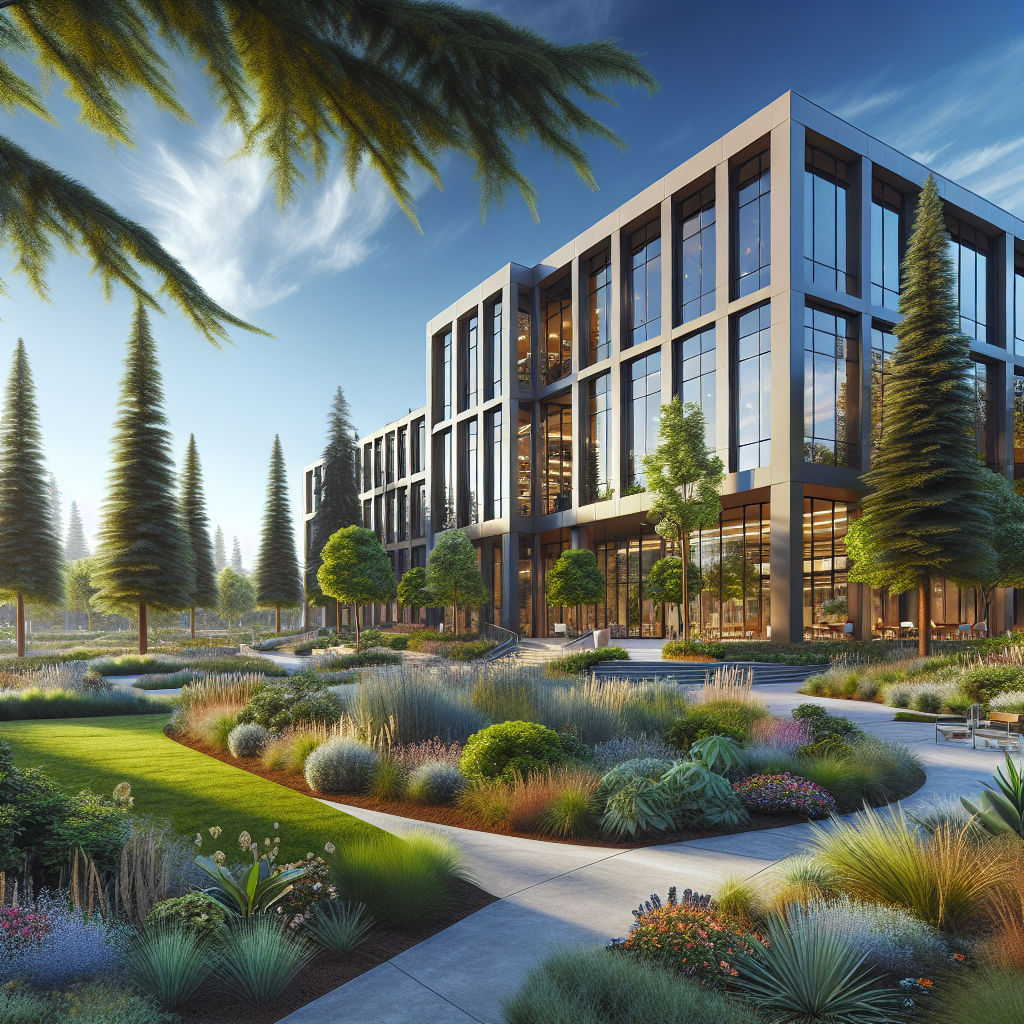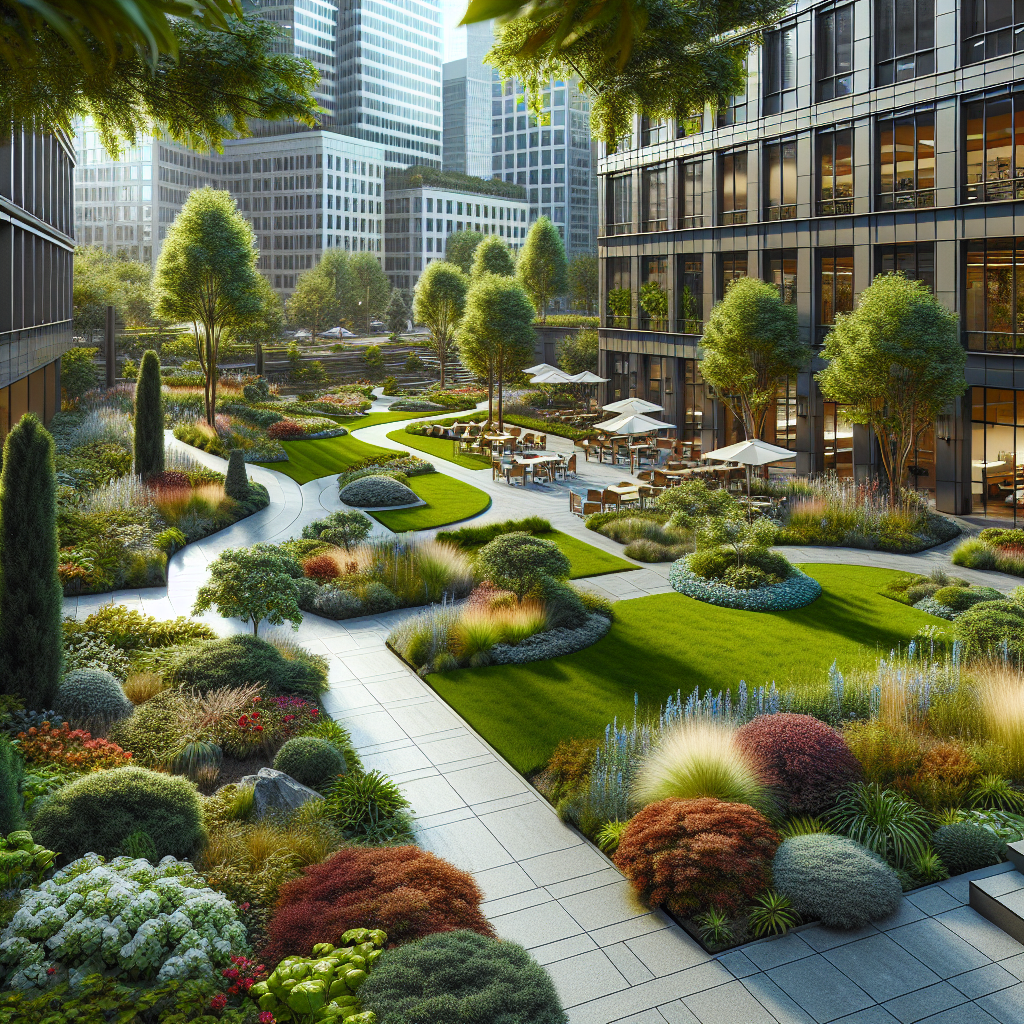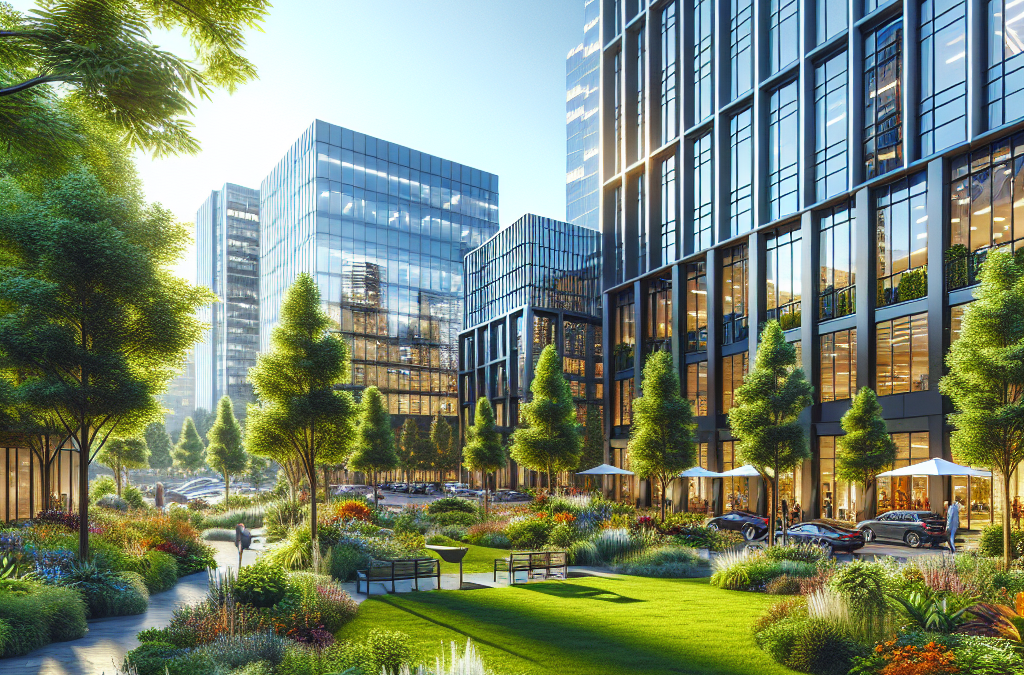Creating an inviting and professional outdoor space is essential for any business. In Portland, Oregon, commercial landscaping design plays a crucial role in establishing a positive first impression for clients, employees, and visitors. Thoughtful landscaping can enhance the aesthetic appeal of a property, increase its value, and create a pleasant environment that reflects the brand’s identity.
Commercial landscaping goes beyond just planting trees and shrubs; it encompasses everything from the layout and design of green spaces to the selection of plants that thrive in the local climate. It’s about creating a cohesive and functional outdoor area that complements the architecture of the building and meets the needs of the business.
Whether you’re a small business owner or manage a large commercial property, understanding the fundamentals of commercial landscaping design can help you make informed decisions that benefit your business in the long run. From sustainability practices to seasonal color schemes, every detail matters in creating an outdoor space that stands out.
Ready to transform your commercial property? Contact us today to discover how our landscaping services can transform your property!
Understanding Portland’s Unique Climate

Portland, Oregon, is known for its unique climate, which significantly influences commercial landscaping design choices. The city experiences a temperate maritime climate, characterized by mild, wet winters and warm, dry summers. Understanding these climatic conditions is essential for creating a thriving and sustainable landscape.
One of the key factors to consider is Portland’s average annual rainfall, which can exceed 40 inches. This abundant rainfall means that selecting plants with good drainage capabilities is crucial to prevent root rot and other water-related issues. Additionally, the wet season, which spans from October to May, requires careful planning to ensure that landscapes remain visually appealing even during the rainiest months.
During the summer, Portland experiences a dry period with little to no rainfall. This dry spell necessitates the use of drought-tolerant plants and efficient irrigation systems to maintain the health and vitality of the landscape. Incorporating native plants, which are well-adapted to the local climate, can reduce water usage and contribute to a more sustainable design.
Furthermore, Portland’s relatively mild temperatures allow for a diverse range of plant species to thrive. However, it is essential to consider microclimates within the city, as variations in elevation and proximity to water bodies can create different growing conditions. By understanding and leveraging these microclimates, landscapers can create diverse and resilient outdoor spaces that flourish year-round.
Overall, a deep understanding of Portland’s unique climate is the foundation for successful commercial landscaping design, ensuring that the landscape remains vibrant and functional throughout the year.
Choosing the Right Plants for Portland
When it comes to Portland Oregon commercial landscaping design, choosing the right plants is paramount. The region’s distinctive climate, characterized by wet winters and dry summers, necessitates selecting plant species that can thrive in these conditions.
First and foremost, it is beneficial to incorporate native plants into your landscape design. Native plants are naturally adapted to Portland’s climate and soil conditions, making them more resilient and requiring less maintenance. Examples of native plants include the Oregon grape, sword fern, and red-flowering currant. These plants not only thrive but also support local wildlife and promote biodiversity.
Another important consideration is the selection of drought-tolerant plants, especially for the summer months when rainfall is scarce. Plants such as lavender, ornamental grasses, and sedum varieties are excellent choices for their ability to withstand dry spells. These plants help in reducing water consumption and ensuring the landscape remains lush and vibrant during the dry season.
Additionally, integrating a mix of evergreen and deciduous plants can provide year-round interest and color. Evergreens like the Western red cedar and Douglas fir maintain their foliage throughout the year, offering consistent greenery. In contrast, deciduous trees and shrubs, such as Japanese maple and hydrangeas, add seasonal variety with their changing leaves and blooms.
It’s also important to consider the specific needs of your commercial property. For example, low-growing ground covers like creeping thyme or periwinkle can be used in high-traffic areas to reduce soil erosion and minimize maintenance. Meanwhile, taller shrubs and trees can be strategically placed to create natural barriers, enhance privacy, or provide shade.
By carefully selecting plants that are well-suited to Portland’s unique climate and the specific needs of your commercial space, you can create a sustainable and visually appealing landscape that stands the test of time.
Sustainable Landscaping Practices

Incorporating sustainable landscaping practices into your Portland Oregon commercial landscaping design is not only environmentally responsible but also economically beneficial. Sustainable landscaping emphasizes practices that conserve resources, reduce waste, and create healthier outdoor environments.
One of the key principles of sustainable landscaping is water conservation. Implementing efficient irrigation systems, such as drip irrigation or smart controllers, ensures that water is used judiciously. These systems deliver water directly to the plant roots, minimizing evaporation and reducing water usage. Additionally, incorporating rainwater harvesting systems can provide a supplemental water source, further reducing dependence on municipal water supplies.
Soil health is another critical aspect of sustainable landscaping. Healthy soil promotes robust plant growth and reduces the need for chemical fertilizers. Practices such as composting and mulching enhance soil fertility and structure. Compost adds essential nutrients back into the soil, while mulch helps retain moisture, suppress weeds, and regulate soil temperature. Using organic mulches like wood chips or straw is particularly beneficial.
Another important practice is the reduction of lawn areas. Lawns typically require significant water, fertilizers, and maintenance. Replacing portions of traditional turf with native grasses, ground covers, or ornamental beds can significantly cut down resource usage. Moreover, these alternatives increase biodiversity and create habitats for local wildlife.
Integrated Pest Management (IPM) is a sustainable approach to managing pests that minimizes the use of harmful chemicals. IPM involves monitoring pest levels, using biological controls like beneficial insects, and applying chemical treatments only when necessary. This approach ensures that pest control measures are effective while preserving the health of the ecosystem.
Finally, selecting climate-appropriate and low-maintenance plants is crucial. As previously mentioned, native and drought-tolerant species are excellent choices. These plants are naturally adapted to the local environment, requiring less water, fertilizer, and overall care.
By adopting these sustainable landscaping practices, you not only contribute to environmental preservation but also create a more efficient and cost-effective landscape for your commercial property.
Incorporating Hardscape Elements

Incorporating hardscape elements into your Portland Oregon commercial landscaping design can significantly enhance both the functionality and aesthetic appeal of your outdoor space. Hardscape elements refer to the non-living components of landscape architecture, such as walkways, patios, retaining walls, and water features.
One of the primary benefits of hardscape elements is that they provide structure and definition to your landscape. Walkways, for example, guide visitors through your property, creating a more organized and accessible space. Whether you opt for natural stone, pavers, or concrete, well-designed walkways can complement your landscape’s style and improve overall flow.
Patios and seating areas are another essential hardscape feature. These spaces offer functional areas for employees, clients, and visitors to relax, socialize, or conduct meetings outdoors. Using materials like flagstone, brick, or stamped concrete, you can create inviting and durable outdoor living spaces that reflect your business’s character.
Retaining walls serve both practical and aesthetic purposes. They help manage soil erosion, level uneven terrain, and create visually striking terraces. Materials such as stone, brick, or concrete blocks can be used to construct retaining walls that blend seamlessly with the surrounding landscape. Additionally, retaining walls can double as seating areas or planter beds, adding versatility to your design.
Water features, such as fountains, ponds, or waterfalls, introduce a sense of tranquility and elegance to commercial landscapes. The soothing sounds of flowing water can create a calming atmosphere, making your property more inviting. Moreover, water features can serve as focal points, drawing attention to specific areas of your landscape and enhancing its visual appeal.
Outdoor lighting is another critical hardscape element that should not be overlooked. Proper illumination not only extends the usability of your outdoor spaces into the evening but also enhances safety and security. From pathway lights to accent lighting for architectural features, there are numerous options to highlight the best aspects of your landscape.
By thoughtfully integrating hardscape elements into your commercial landscaping, you can create a more functional, attractive, and cohesive outdoor environment that reflects your business’s identity and values.
Maintenance Tips for Longevity

Ensuring the longevity of your Portland Oregon commercial landscaping design requires regular and thoughtful maintenance. A well-maintained landscape not only enhances your property’s curb appeal but also contributes to a positive impression on clients and visitors. Here are some essential maintenance tips to help you keep your commercial landscape in top shape:
- Regular Watering: Consistent and adequate watering is crucial for the health of your plants. Consider installing an irrigation system to ensure even and efficient water distribution. Adjust the watering schedule based on the season and specific needs of your plants.
- Mulching: Apply mulch around trees, shrubs, and flower beds to retain moisture, suppress weeds, and regulate soil temperature. Organic mulch, such as wood chips or bark, can also improve soil quality as it decomposes.
- Pruning and Trimming: Regularly prune trees, shrubs, and hedges to promote healthy growth and maintain a tidy appearance. Removing dead or diseased branches prevents the spread of pests and diseases, while trimming helps shape plants and control their size.
- Fertilization: Periodically fertilize your plants to provide essential nutrients for their growth. Use a balanced fertilizer and follow the recommended application rates to avoid over-fertilization, which can harm your plants and the environment.
- Pest and Disease Control: Monitor your landscape for signs of pests and diseases. Early detection and treatment are key to preventing significant damage. Integrated pest management (IPM) strategies, which combine biological, cultural, and chemical methods, can effectively manage pest issues.
- Weed Management: Regularly remove weeds to prevent them from competing with your plants for nutrients and water. Use mulch, hand-pulling, and herbicides as necessary to keep weeds under control.
- Soil Health: Test your soil periodically to ensure it has the right pH and nutrient levels. Amending the soil with compost or other organic matter can improve its structure and fertility, promoting healthier plant growth.
- Seasonal Clean-Up: Perform seasonal clean-ups to remove fallen leaves, debris, and any dead plant material. This helps maintain a neat appearance and reduces the risk of pest infestations and diseases.
By following these maintenance tips, you can ensure that your commercial landscape remains vibrant and attractive throughout the year. A well-maintained landscape not only boosts your property’s aesthetic appeal but also reflects your commitment to quality and professionalism.
Contact us today to discover how our landscaping services can transform your property! Visit yardservicepdx.com to learn more.

